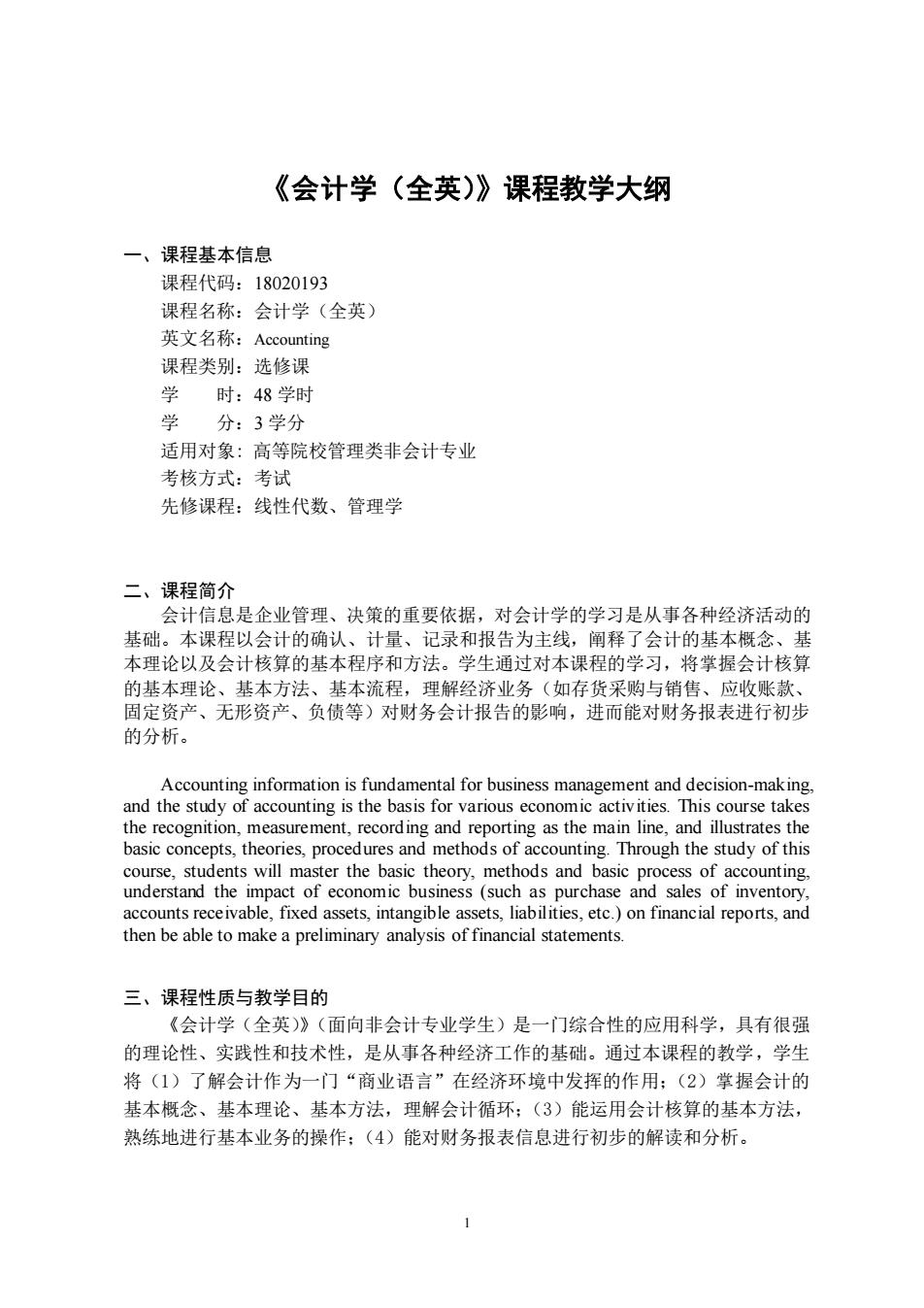
《会计学(全英)》课程教学大纲 一、课程基本信息 课程代码:18020193 课程名称:会计学(全英) 英文名称:Accounting 课程类谢:选修课 学时:48学时 学 分:3学分 适用对象:高等院校管理类非会计专业 考核方式:考试 先修课程:线性代数、管理学 二、课程简介 会计信息是企业管理、决策的重要依据,对会计学的学习是从事各种经济活动的 基础 本课程以会计的确认、 记录和报告为主线 阐释了会计的基本概 本理论以及会计核算的基本程序和方法。学生通过对本课程的学习,将掌握会计核算 的基本理论、基本方法、基本流程,理解经济业务(如存货采购与销售、应收账款、 固定资产、无形资产、负债等)对财务会计报告的影响,进而能对财务报表进行初步 的分析。 ting information is fundamental for business ma agement and decision is the basis for course take th ecord nd orting as the dy act of eco and sales of in accounts receivable.fixed assets.intangible assets.liabilities.etc.)on financial reports.and then be able to make a preliminary analysis of financial statements. 三、课程性质与教学目的 《会计学(全英)》(面向非会计专业学牛)是一门综合性的应用科学,具有很强 的理论性、实践性和技术性,是从事各种经济工作的基础。通过本课程的教学,学生 将(1)了解会计作为一门“商业语言”在经济环境中发挥的作用:(2)掌握会计的 基本概念、基本理论、基本方法,理解会计循环:(3)能运用会计核算的基本方法, 熟练地进行基本业务的操作:(4)能对财务报表信息进行初步的解读和分析。 1
1 《会计学(全英)》课程教学大纲 一、课程基本信息 课程代码:18020193 课程名称:会计学(全英) 英文名称:Accounting 课程类别:选修课 学 时:48 学时 学 分:3 学分 适用对象: 高等院校管理类非会计专业 考核方式:考试 先修课程:线性代数、管理学 二、课程简介 会计信息是企业管理、决策的重要依据,对会计学的学习是从事各种经济活动的 基础。本课程以会计的确认、计量、记录和报告为主线,阐释了会计的基本概念、基 本理论以及会计核算的基本程序和方法。学生通过对本课程的学习,将掌握会计核算 的基本理论、基本方法、基本流程,理解经济业务(如存货采购与销售、应收账款、 固定资产、无形资产、负债等)对财务会计报告的影响,进而能对财务报表进行初步 的分析。 Accounting information is fundamental for business management and decision-making, and the study of accounting is the basis for various economic activities. This course takes the recognition, measurement, recording and reporting as the main line, and illustrates the basic concepts, theories, procedures and methods of accounting. Through the study of this course, students will master the basic theory, methods and basic process of accounting, understand the impact of economic business (such as purchase and sales of inventory, accounts receivable, fixed assets, intangible assets, liabilities, etc.) on financial reports, and then be able to make a preliminary analysis of financial statements. 三、课程性质与教学目的 《会计学(全英)》(面向非会计专业学生)是一门综合性的应用科学,具有很强 的理论性、实践性和技术性,是从事各种经济工作的基础。通过本课程的教学,学生 将(1)了解会计作为一门“商业语言”在经济环境中发挥的作用;(2)掌握会计的 基本概念、基本理论、基本方法,理解会计循环;(3)能运用会计核算的基本方法, 熟练地进行基本业务的操作;(4)能对财务报表信息进行初步的解读和分析
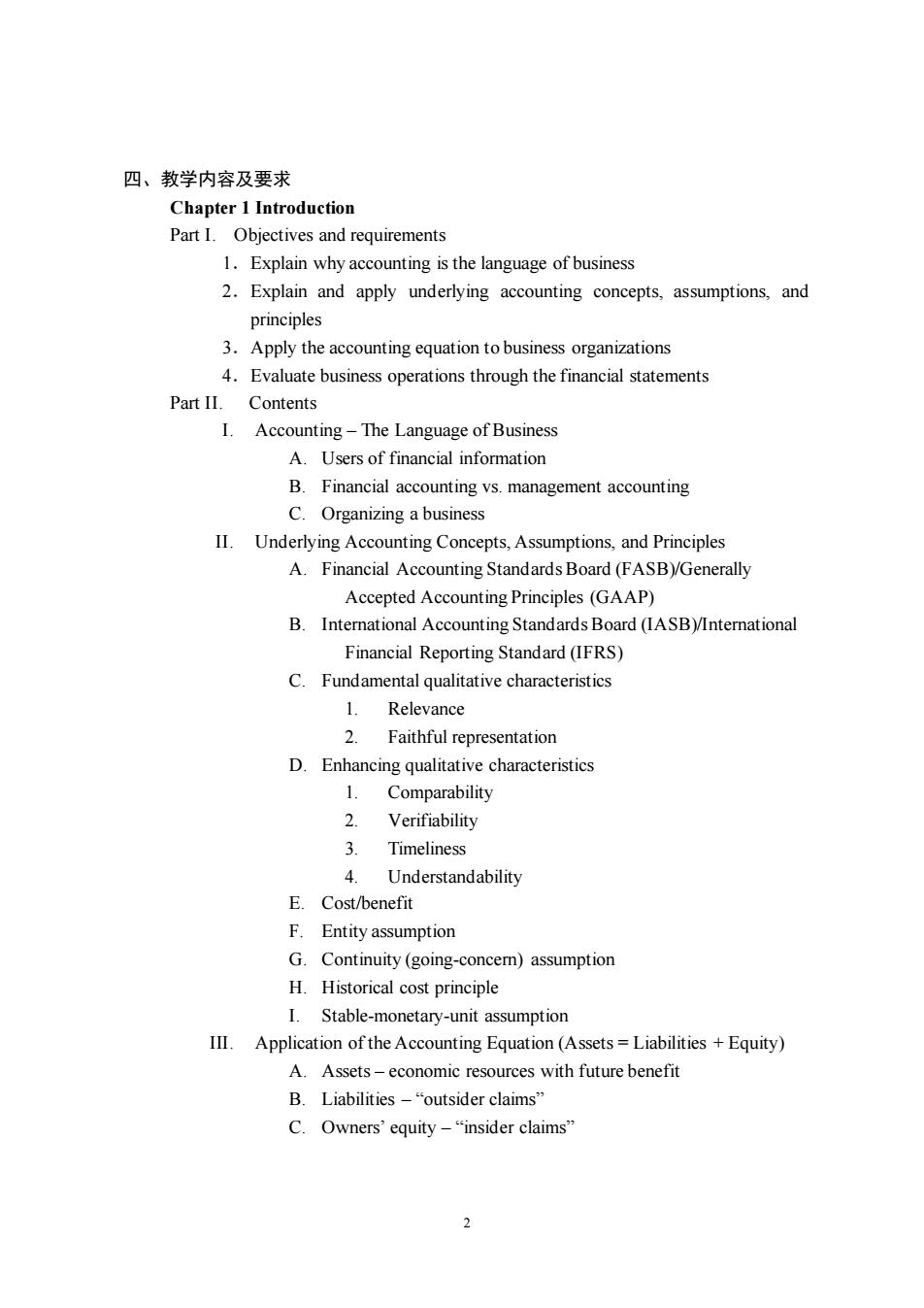
四、教学内容及要求 Chapter 1 Introduction Part I.Objectives and requirements 1.Explain why accounting is the language of business 2.Explain and apply underlying accounting concepts,assumptions,and principles 3.Apply the accounting equation to business organizations 4.Evaluate business operations through the financial statements Part II.Contents I.Accounting-The Language of Business A.Users of financial information B.Financial accounting vs.management accounting C.Organizing a business II.Underlying Accounting Concepts,Assumptions,and Principles A.Financial Accounting Standards Board(FASB)/Generally Accepted Accounting Principles (GAAP) B.Intemnational Accounting Standards Board(IASB)Interational Financial Reporting Standard (IFRS) C.Fundamental qualitative characteristics Relevance Faithful representation D.Enhancing qualitative characteristics 1 Comparability 2. Verifiability 3 Timeliness 4. Understandability E.Cost/benefit F.Entity assumption G.Continuity(going-concem)assumption H.Historical cost principle I.Stable-monetary-unit assumption III.Application of the Accounting Equation(Assets=Liabilities +Equity) A.Assets-economic resources with future benefit B.Liabilities-“outsider claims'” C.Owners'equity-"insider claims
2 四、教学内容及要求 Chapter 1 Introduction Part I. Objectives and requirements 1.Explain why accounting is the language of business 2.Explain and apply underlying accounting concepts, assumptions, and principles 3.Apply the accounting equation to business organizations 4.Evaluate business operations through the financial statements Part II. Contents I. Accounting – The Language of Business A. Users of financial information B. Financial accounting vs. management accounting C. Organizing a business II. Underlying Accounting Concepts, Assumptions, and Principles A. Financial Accounting Standards Board (FASB)/Generally Accepted Accounting Principles (GAAP) B. International Accounting Standards Board (IASB)/International Financial Reporting Standard (IFRS) C. Fundamental qualitative characteristics 1. Relevance 2. Faithful representation D. Enhancing qualitative characteristics 1. Comparability 2. Verifiability 3. Timeliness 4. Understandability E. Cost/benefit F. Entity assumption G. Continuity (going-concern) assumption H. Historical cost principle I. Stable-monetary-unit assumption III. Application of the Accounting Equation (Assets = Liabilities + Equity) A. Assets – economic resources with future benefit B. Liabilities – “outsider claims” C. Owners’ equity – “insider claims
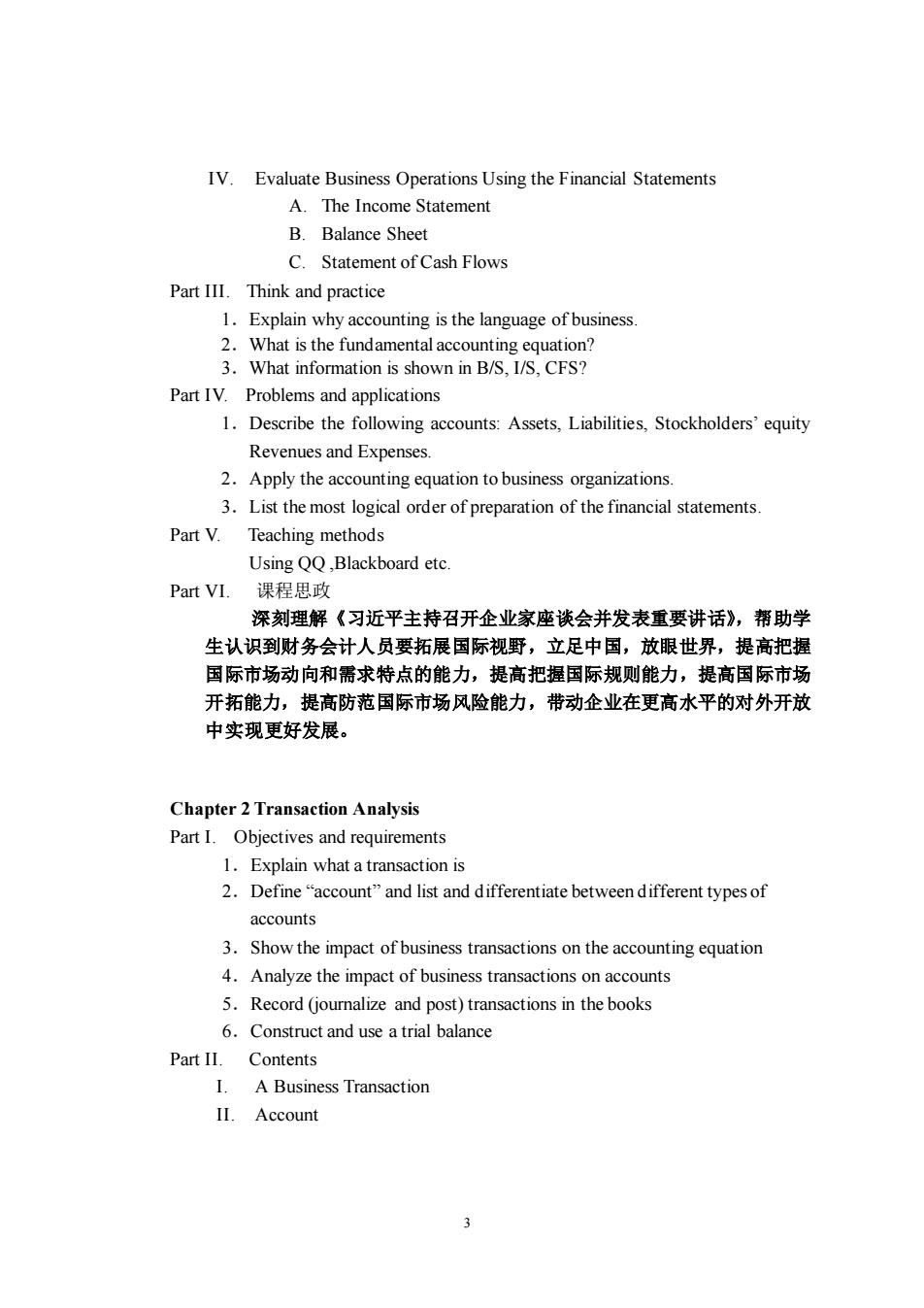
IV.Evaluate Business Operations Using the Financial Statements A.The Income Statement B Balance Sheet C.Statement of Cash Flows Part III.Think and practice 1.Explain why accounting is the language of business 2.What is the fundamental accounting equation? 3.What information is shown in B/S,I/S,CFS? Part IV.Problems and applications 1.Describe the following accounts:Assets,Liabilities,Stockholders'equity Revenues and Expenses 2.Apply the accounting equation to business organizations. 3.List the most logical order of preparation of the financial statements Part V.Teaching methods Using QQ,Blackboard etc. Part VI. 课程思政 深刻理解《习近平主持召开企业家座谈会并发表重要讲话》,帮助学 生认识到财务会计人员要拓展国际视野,立足中国,放眼世界,提高把握 国际市场动向和需求特点的能力,提高把握国际规则能力,提高国际市场 开拓能力,提高防范国际市场风险能力,带动企业在更高水平的对外开放 中实现更好发展。 Chapter 2 Transaction Analysis Part 1.Objectives and requirements 1.Explain what a transaction is 2.Define"account"and list and differentiate between different types of accounts 3.Show the impact of business transactions on the accounting equation 4.Analyze the impact of business transactions on accounts 5.Record(jouralize and post)transactions in the books 6.Construct and use a trial balance Part II.Contents I.A Business Transaction II.Account 3
3 IV. Evaluate Business Operations Using the Financial Statements A. The Income Statement B. Balance Sheet C. Statement of Cash Flows Part III. Think and practice 1.Explain why accounting is the language of business. 2.What is the fundamental accounting equation? 3.What information is shown in B/S, I/S, CFS? Part IV. Problems and applications 1.Describe the following accounts: Assets, Liabilities, Stockholders’ equity Revenues and Expenses. 2.Apply the accounting equation to business organizations. 3.List the most logical order of preparation of the financial statements. Part V. Teaching methods Using QQ ,Blackboard etc. Part VI. 课程思政 深刻理解《习近平主持召开企业家座谈会并发表重要讲话》,帮助学 生认识到财务会计人员要拓展国际视野,立足中国,放眼世界,提高把握 国际市场动向和需求特点的能力,提高把握国际规则能力,提高国际市场 开拓能力,提高防范国际市场风险能力,带动企业在更高水平的对外开放 中实现更好发展。 Chapter 2 Transaction Analysis Part I. Objectives and requirements 1.Explain what a transaction is 2.Define “account” and list and differentiate between different types of accounts 3.Show the impact of business transactions on the accounting equation 4.Analyze the impact of business transactions on accounts 5.Record (journalize and post) transactions in the books 6.Construct and use a trial balance Part II. Contents I. A Business Transaction II. Account
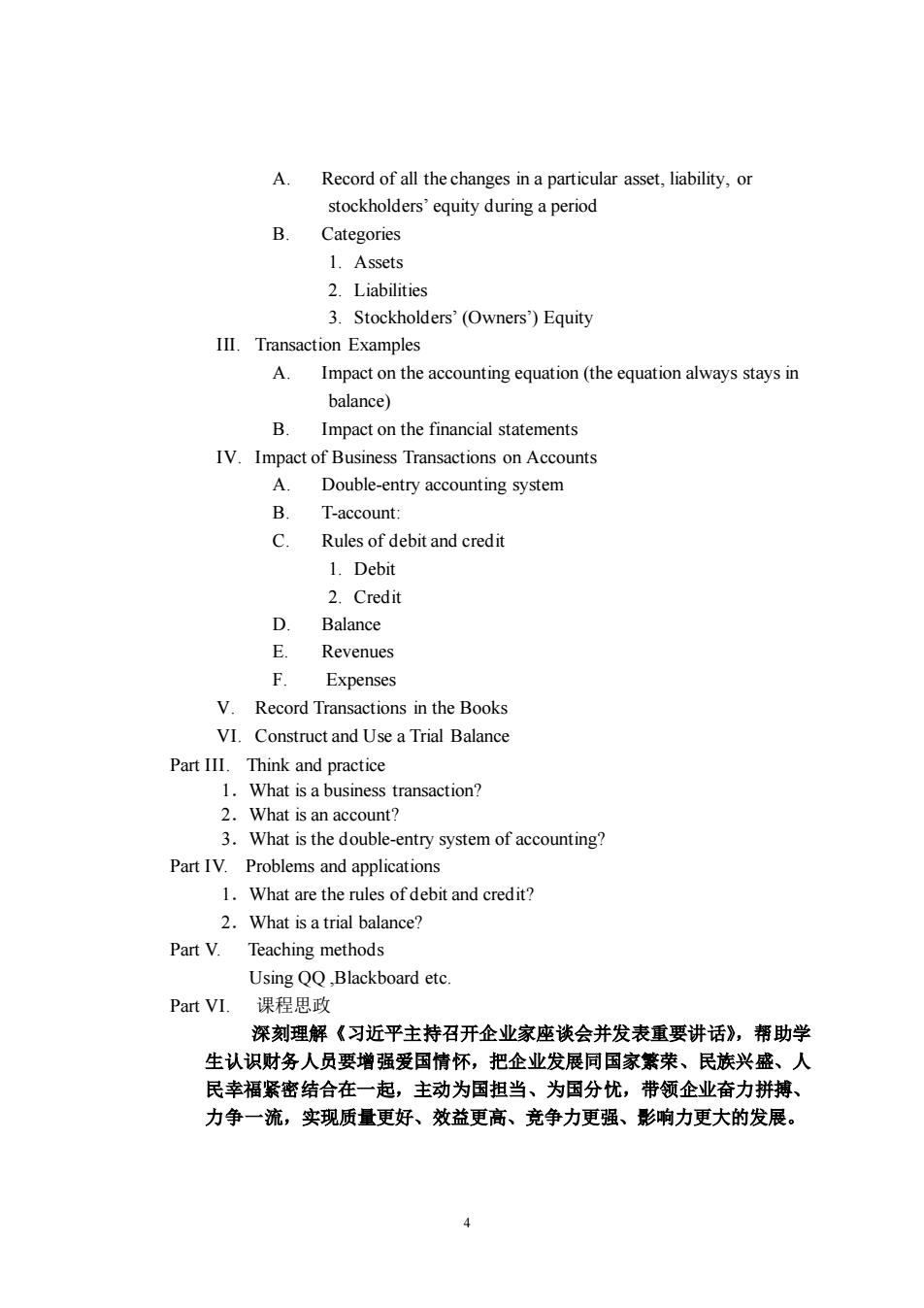
A.Record of all the changes in a particular asset,liability,or stockholders'equity during a period B.Categories 1.Assets 2.Liabilities 3.Stockholders'(Owners)Equity III.Transaction Examples A. Impact on the accounting equation(the equation always stays in balance) B. Impact on the financial statements IV.Impact of Business Transactions on Accounts A Double-entry accounting system B. T-account: C. Rules of debit and credit 1 Debit 2.Credit D Balance 6 Revenues F Expenses V.Record Transactions in the Books VI.Construct and Use a Trial Balance Part III.Think and practice 1.What is a business transaction? 2 What is an ac unt? 3.What is the doub-enysystem of ccounting? Part IV.Problems and applications 1.What are the rules of debit and credit? 2.What is a trial balance? Part V. Teaching methods Using OO Blackboard etc Part VI. 课程思政 深刻理解《习近平主持召开企业家座谈会并发表重要讲话》,帮助学 生认识财务人员要增强爱国情怀,把企业发展同国家繁荣、民族兴盛、人 民幸福紧密结合在一起,主动为国担当、为国分忧,带领企业奋力拼搏、 力争一流,实现质量更好、效益更高、竞争力更强、形响力更大的发展。 4
4 A. Record of all the changes in a particular asset, liability, or stockholders’ equity during a period B. Categories 1. Assets 2. Liabilities 3. Stockholders’ (Owners’) Equity III. Transaction Examples A. Impact on the accounting equation (the equation always stays in balance) B. Impact on the financial statements IV. Impact of Business Transactions on Accounts A. Double-entry accounting system B. T-account: C. Rules of debit and credit 1. Debit 2. Credit D. Balance E. Revenues F. Expenses V. Record Transactions in the Books VI. Construct and Use a Trial Balance Part III. Think and practice 1.What is a business transaction? 2.What is an account? 3.What is the double-entry system of accounting? Part IV. Problems and applications 1.What are the rules of debit and credit? 2.What is a trial balance? Part V. Teaching methods Using QQ ,Blackboard etc. Part VI. 课程思政 深刻理解《习近平主持召开企业家座谈会并发表重要讲话》,帮助学 生认识财务人员要增强爱国情怀,把企业发展同国家繁荣、民族兴盛、人 民幸福紧密结合在一起,主动为国担当、为国分忧,带领企业奋力拼搏、 力争一流,实现质量更好、效益更高、竞争力更强、影响力更大的发展
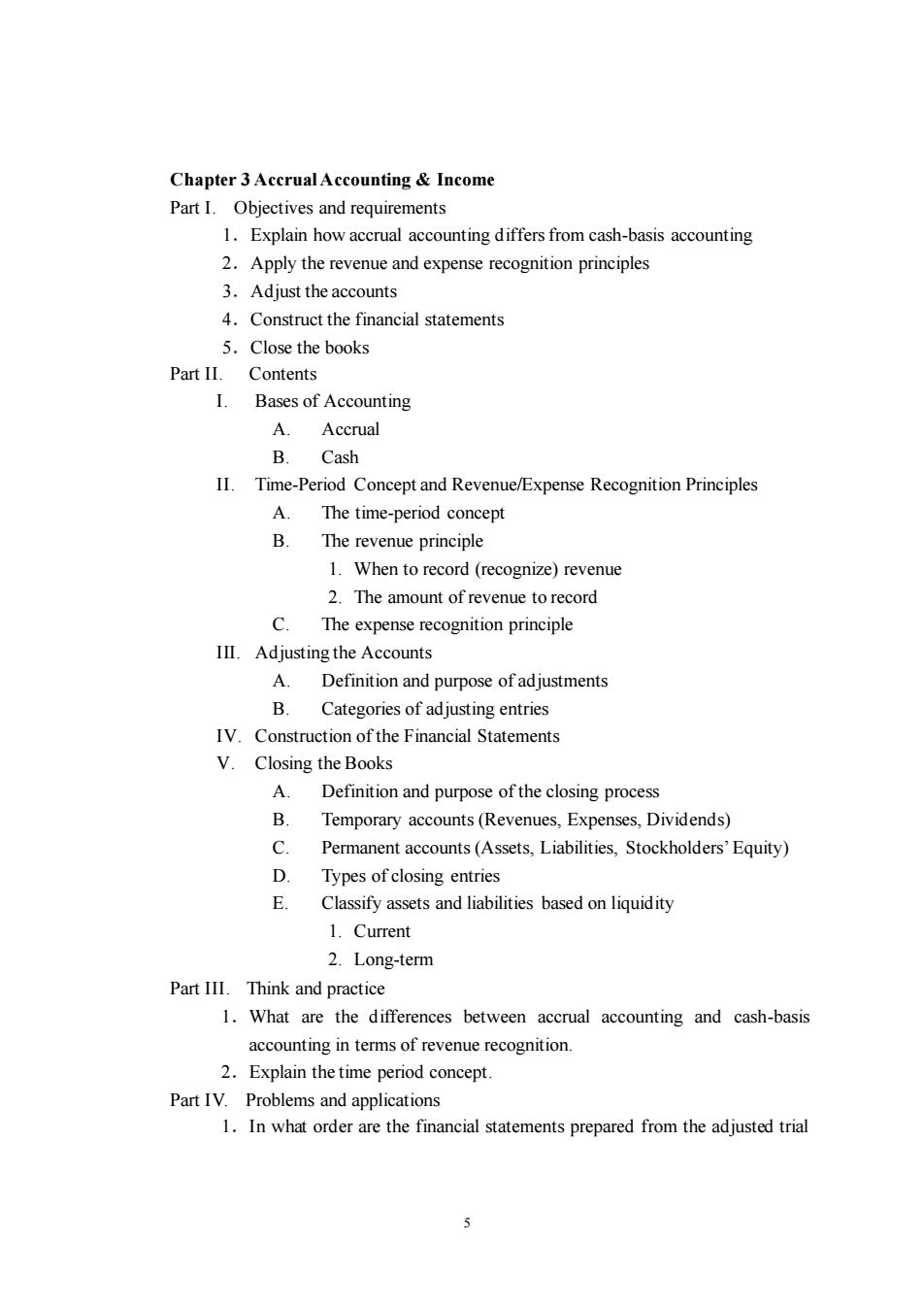
Chapter 3 Accrual Accounting Income Part I.Objectives and requirements 1.Explain how accrual accounting differs from cash-basis accounting 2.Apply the revenue and expense recognition principles 3.Adiust the accounts 4.Construct the financial statements 5.Close the books Part II. Contents I.Bases of Accounting Accrual B Cash II.Time-Period Concept and Revenue/Expense Recognition Principle A The time-period concept B The revenue principle 1.When to record(recognize)revenue 2.The amount of revenue to record The expense recognition principle III.Adjusting the Accounts A Definition and purpose ofadjustments B Categories of ad justing entries IV.Construction of the Financial Statements V.Closing the Books A Definition and purpose of the closing process Temporary accounts (Revenues.Expenses,Dividends) Permanent accounts(Assets,Liabilities,Stockholders'Equity) D Types of closing entries E Classify assets and liabilities based on liquidity 1.Current 2.Long-term Part III.Think and practice 1.What are the differences between accrual accounting and cash-basis accounting in terms of revenue recognition. 2.Explain the time period concept Part IV.Problems and applications 1.In what order are the financial statements prepared from the adjusted trial 5
5 Chapter 3 Accrual Accounting & Income Part I. Objectives and requirements 1.Explain how accrual accounting differs from cash-basis accounting 2.Apply the revenue and expense recognition principles 3.Adjust the accounts 4.Construct the financial statements 5.Close the books Part II. Contents I. Bases of Accounting A. Accrual B. Cash II. Time-Period Concept and Revenue/Expense Recognition Principles A. The time-period concept B. The revenue principle 1. When to record (recognize) revenue 2. The amount of revenue to record C. The expense recognition principle III. Adjusting the Accounts A. Definition and purpose of adjustments B. Categories of adjusting entries IV. Construction of the Financial Statements V. Closing the Books A. Definition and purpose of the closing process B. Temporary accounts (Revenues, Expenses, Dividends) C. Permanent accounts (Assets, Liabilities, Stockholders’ Equity) D. Types of closing entries E. Classify assets and liabilities based on liquidity 1. Current 2. Long-term Part III. Think and practice 1.What are the differences between accrual accounting and cash-basis accounting in terms of revenue recognition. 2.Explain the time period concept. Part IV. Problems and applications 1.In what order are the financial statements prepared from the adjusted trial

balance? 2.How do the income statement,statement of retained earnings,balance sheet,and cash flow statement tie to each other? Part V. Teaching methods Using QQ,Blackboard etc Part VI. 更理思政 深刻理解《习近平主持召开企业家座谈会并发表重要讲话》,帮助学 生认识到财务人员要做诚信守法的表率,带动全社会道德素质和文明程度 提升。 Chapter 4 Internal Control Cash Part I.Objectives and requirements 1.Describe fraud and its impact 2.Explain the objectives and components of internal control 3.Evaluate intemal controls over cash receipts and cash payments 4.Report cash on the balance sheet Part II. Contents I.Fraud and Its Impact Definition of fraud B Types of fraud Fraud and business ethics II.Objectives and Components of Intemal Control A. Objectives of internal contro B Sarbanes-Oxlev Act(SOX) c Components of internal control 1.Control environment 2.Risk assessment 3.Information system 4.Control procedures 5.Monitoring of controls D Internal control procedures E Information technology F Safeguard controls G. Internal controls for e-commerce 6
6 balance? 2.How do the income statement, statement of retained earnings, balance sheet, and cash flow statement tie to each other? Part V. Teaching methods Using QQ ,Blackboard etc. Part VI. 课程思政 深刻理解《习近平主持召开企业家座谈会并发表重要讲话》,帮助学 生认识到财务人员要做诚信守法的表率,带动全社会道德素质和文明程度 提升。 Chapter 4 Internal Control & Cash Part I. Objectives and requirements 1.Describe fraud and its impact 2.Explain the objectives and components of internal control 3.Evaluate internal controls over cash receipts and cash payments 4.Report cash on the balance sheet Part II. Contents I. Fraud and Its Impact A. Definition of fraud B. Types of fraud C. Fraud and business ethics II. Objectives and Components of Internal Control A. Objectives of internal control B. Sarbanes-Oxley Act (SOX) C. Components of internal control 1. Control environment 2. Risk assessment 3. Information system 4. Control procedures 5. Monitoring of controls D. Internal control procedures E. Information technology F. Safeguard controls G. Internal controls for E-commerce
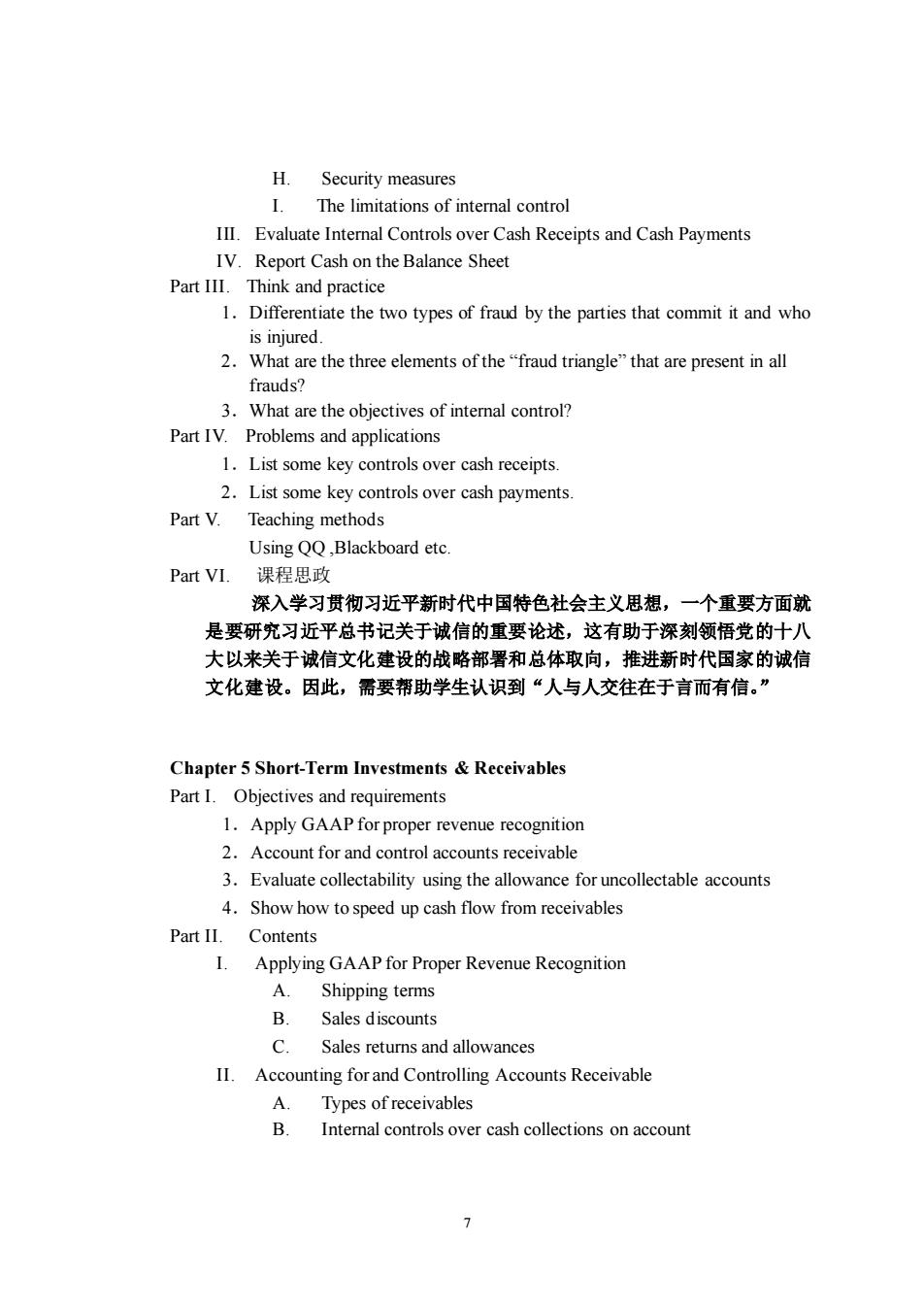
H.Security measures I.The limitations of interal contro III.Evaluate Internal Controls over Cash Receipts and Cash Payments IV.Report Cash on the Balance Sheet Part III.Think and practice 1.Differentiate the two types of fraud by the parties that commit it and who is injured. 2.Wha the three elements of the taud tangle that are present a 3.What are the objectives of internal control? Part IV.Problems and applications 1.List some key controls over cash receipts. 2.List some key controls over cash payments. Part V. leaching methods Using QQ.Blackboard etc Part VI. 课程思政 深入学习贯彻习近平新时代中国特色杜会主义思想,一个重要方面就 是要研究习近平总书记关于诚信的重要论述,这有助于深刻领悟党的十八 大以来关于诚信文化建设的战略部署和总体取向,推进新时代国家的诚信 文化建设。因此,需要帮助学生认识到“人与人交往在于言而有信. Chapter 5 Short-Term Investments Receivables Part I.Objectives and requirements 1.Apply GAAP for proper revenue recognition 2.Account for and control accounts receivable 3.Evaluate collectability using the allowance for uncollectable accounts 4.Show how to speed up cash flow from receivables Part II.Contents Applying GAAP for Proper Revenue Recognition A Shipping terms Sales discounts Sales returns and allowances II.Accounting for and Controlling Accounts Receivable Types of receivables B Internal controls over cash collections on account
7 H. Security measures I. The limitations of internal control III. Evaluate Internal Controls over Cash Receipts and Cash Payments IV. Report Cash on the Balance Sheet Part III. Think and practice 1.Differentiate the two types of fraud by the parties that commit it and who is injured. 2.What are the three elements of the “fraud triangle” that are present in all frauds? 3.What are the objectives of internal control? Part IV. Problems and applications 1.List some key controls over cash receipts. 2.List some key controls over cash payments. Part V. Teaching methods Using QQ ,Blackboard etc. Part VI. 课程思政 深入学习贯彻习近平新时代中国特色社会主义思想,一个重要方面就 是要研究习近平总书记关于诚信的重要论述,这有助于深刻领悟党的十八 大以来关于诚信文化建设的战略部署和总体取向,推进新时代国家的诚信 文化建设。因此,需要帮助学生认识到“人与人交往在于言而有信。” Chapter 5 Short-Term Investments & Receivables Part I. Objectives and requirements 1.Apply GAAP for proper revenue recognition 2.Account for and control accounts receivable 3.Evaluate collectability using the allowance for uncollectable accounts 4.Show how to speed up cash flow from receivables Part II. Contents I. Applying GAAP for Proper Revenue Recognition A. Shipping terms B. Sales discounts C. Sales returns and allowances II. Accounting for and Controlling Accounts Receivable A. Types of receivables B. Internal controls over cash collections on account
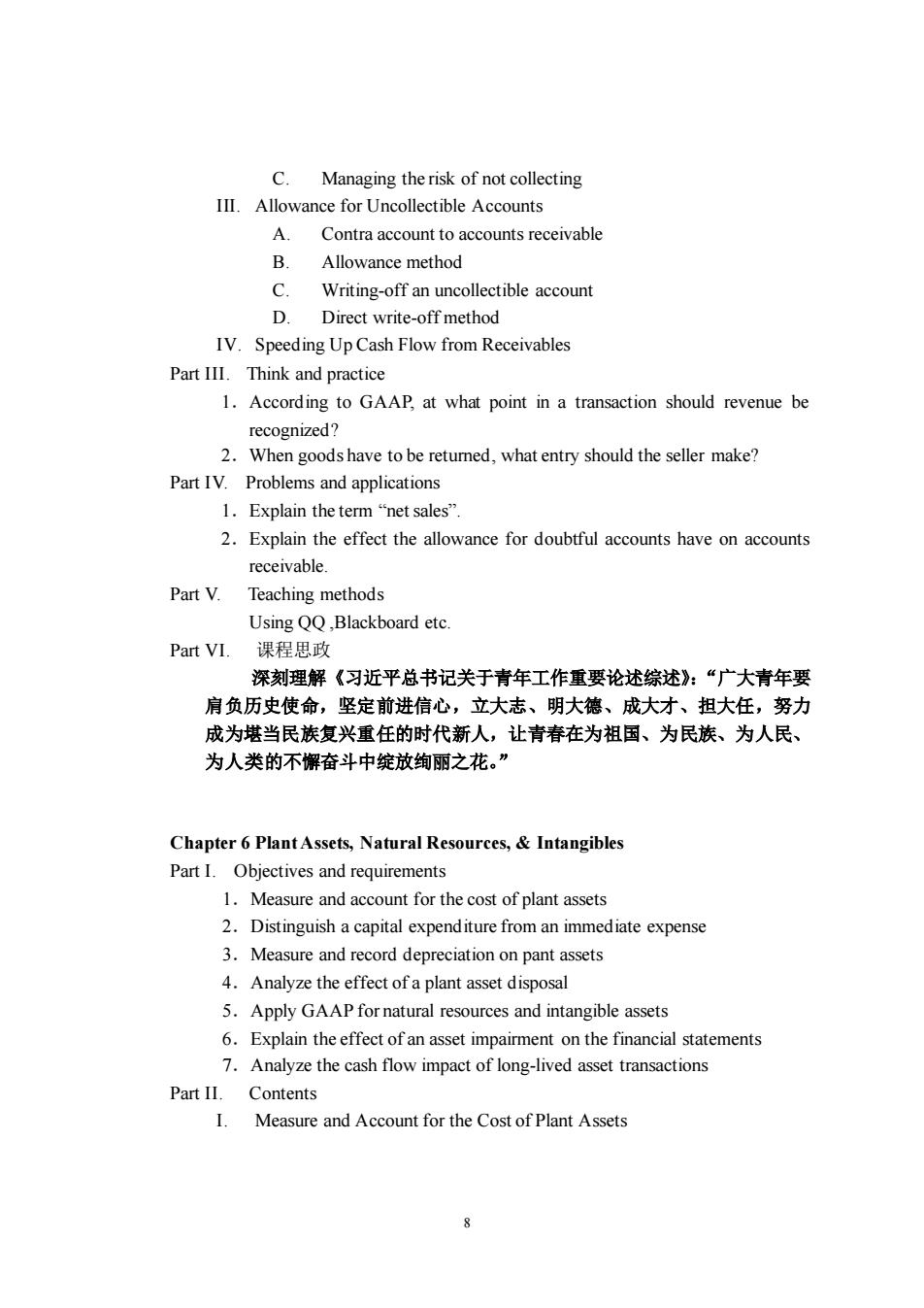
C.Managing the risk of not collecting III.Allowance for Uncollectible Accounts A Contra account to accounts receivable B Allowance method C Writing-off an uncollectible account D Direct write-offmethod IV.Speeding Up Cash Flow from Receivables Part III.Think and practice 1.According to GAAP,at what point in a transaction should revenue be recognized? 2.When goods have to be retumed,what entry should the seller make? Part IV.Problems and applications l.Explain the term“"net sales'” 2.Explain the effect the allowance for doubtful accounts have on accounts receivable. Part V. Teaching methods Using OO Blackboard etc Part VI. 课程思政 深刻理解《习近平总书记关于青年工作重要论述综述》:“广大青年要 肩负历史使命,坚定前进信心,立大志、明大德、成大才、担大任,努力 成为堪当民族复兴重任的时代新人,让青春在为祖国、为民族、为人民、 为人类的不懈奋斗中绽放绚丽之花。” Chapter 6 Plant Assets,Natural Resources,Intangibles Part I.Objectives and requirements 1.Measure and account for the cost of plant assets 2.Distinguish a capital expenditure from an immediate expense 3.Measure and record depreciation on pant assets 4.Analyze the effect ofa plant asset disposal 5.Apply GAAP for natural resources and intangible assets 6.Explain the effect of an asset impairment on the financial statements 7.Analyze the cash flow impact of long-lived asset transactions Part II. Contents I.Measure and Account for the Cost of Plant Assets
8 C. Managing the risk of not collecting III. Allowance for Uncollectible Accounts A. Contra account to accounts receivable B. Allowance method C. Writing-off an uncollectible account D. Direct write-off method IV. Speeding Up Cash Flow from Receivables Part III. Think and practice 1.According to GAAP, at what point in a transaction should revenue be recognized? 2.When goods have to be returned, what entry should the seller make? Part IV. Problems and applications 1.Explain the term “net sales”. 2.Explain the effect the allowance for doubtful accounts have on accounts receivable. Part V. Teaching methods Using QQ ,Blackboard etc. Part VI. 课程思政 深刻理解《习近平总书记关于青年工作重要论述综述》:“广大青年要 肩负历史使命,坚定前进信心,立大志、明大德、成大才、担大任,努力 成为堪当民族复兴重任的时代新人,让青春在为祖国、为民族、为人民、 为人类的不懈奋斗中绽放绚丽之花。” Chapter 6 Plant Assets, Natural Resources, & Intangibles Part I. Objectives and requirements 1.Measure and account for the cost of plant assets 2.Distinguish a capital expenditure from an immediate expense 3.Measure and record depreciation on pant assets 4.Analyze the effect of a plant asset disposal 5.Apply GAAP for natural resources and intangible assets 6.Explain the effect of an asset impairment on the financial statements 7.Analyze the cash flow impact of long-lived asset transactions Part II. Contents I. Measure and Account for the Cost of Plant Assets

A Types of long-lived assets Types of plant assets C Lump-sum(basket)purchases of assets II.Distinguish a Capital Expenditure from an Immediate Expense III.Measure and Record Depreciation on Plant Assets Book value B Depreciation c Measuring depreciation 1 Cost 2.Estimated useful life 3.Estimated residual value D Depreciation methods 1.Straight-line method 2.Double-declining-balance method Comparing depreciation methods IV.Analyze the Effect of a Plant Asset Disposal V.Apply GAAP for Natural Resources and Intangible Assets VI.Explain the Effect of an Asset Impairment on the Financial Statements VII.Analyze the Cash Flow Impact of Long-Lived Asset Transactions Part III.Think and practice 1.At what value are plant assets recorded under GAAP? 2.What is the distinguishing characteristic of a capital expenditure that requires recording it as an asset on the balance sheet rather than as a direct expense e on the income statement? 3.What is depreciation? Part IV.Problems and applications 1.Distinguish between straight-line (SL)and double-declining(DD)method. 2.Explain what is goodwill. Part V. Teaching methods Using QQ,Blackboard etc Part VI. 课程思政 深刻理解《习近平主持召开企业家座谈会并发表重要讲话》,帮助学 生认识到财务人员要在爱国、创新、诚信、社会责任和国际视野等方面不 断提升自已,努力成为新时代构建新发展格局、建设现代化经济体系、推 动高质量发展的生力军。 9
9 A. Types of long-lived assets B. Types of plant assets C. Lump-sum (basket) purchases of assets II. Distinguish a Capital Expenditure from an Immediate Expense III. Measure and Record Depreciation on Plant Assets A. Book value B. Depreciation C. Measuring depreciation 1. Cost 2. Estimated useful life 3. Estimated residual value D. Depreciation methods 1. Straight-line method 2. Double-declining-balance method E. Comparing depreciation methods IV. Analyze the Effect of a Plant Asset Disposal V. Apply GAAP for Natural Resources and Intangible Assets VI. Explain the Effect of an Asset Impairment on the Financial Statements VII. Analyze the Cash Flow Impact of Long-Lived Asset Transactions Part III. Think and practice 1.At what value are plant assets recorded under GAAP? 2.What is the distinguishing characteristic of a capital expenditure that requires recording it as an asset on the balance sheet rather than as a direct expense on the income statement? 3.What is depreciation? Part IV. Problems and applications 1.Distinguish between straight-line (SL) and double-declining (DD) method. 2.Explain what is goodwill. Part V. Teaching methods Using QQ ,Blackboard etc. Part VI. 课程思政 深刻理解《习近平主持召开企业家座谈会并发表重要讲话》,帮助学 生认识到财务人员要在爱国、创新、诚信、社会责任和国际视野等方面不 断提升自己,努力成为新时代构建新发展格局、建设现代化经济体系、推 动高质量发展的生力军
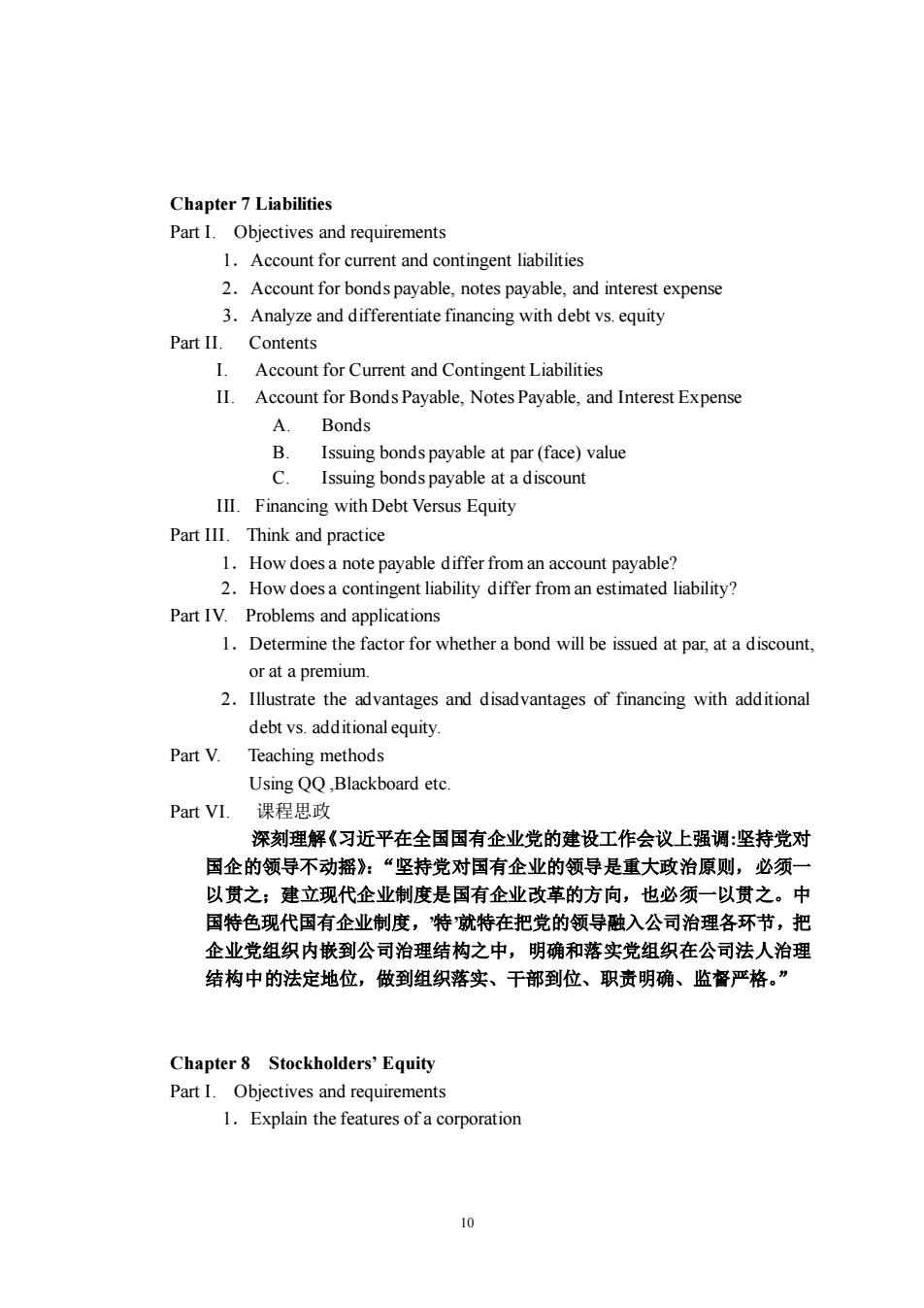
Chapter 7 Liabilities Part I.Objectives and requirements 1.Account for current and contingent liabilities 2.Account for bonds payable,notes payable,and interest expense 3.Analyze and differentiate financing with debt vs.quity Part II. Contents Account for Current and Contingent Liabilities II.Account for Bonds Payable,Notes Payable,and Interest Expense A Bonds Issuing bonds payable at par (face)value C Issuing bonds payable at a discount III.Financing with Debt Versus Equity Part III.Think and practice 1.How does a note payable differ from an account payable? 2.How does a contingent liability differ from an estimated liability? Part IV.Problems and applications 1.Determine the factor for whether a bond will be issued at par,at a discount, or at a premium 2.Illustrate the advantages and disadvantages of financing with additional debt vs. Part V.Teaching methods Using QQ,Blackboard ete Part VI. 课程思政 深刻理解《习近平在全国国有企业党的建设工作会议上强调:坚持党对 国企的领导不动摇》:“坚持党对国有企业的领导是重大政治原则,必须 以贯之;建立现代企业制度是国有企业改革的方向,也必须一以贯之。中 国特色现代国有企业制度,特就特在把党的领导融入公司治理各环节,把 企业党组织内嵌到公司治理结构之中,明确和落实党组织在公司法人治理 结构中的法定地位,做到组织落实、干部到位、职责明确、监唇严格。” Chapter 8 Stockholders'Equity Part I.Objectives and requirements 1.Explain the features of a corporation 10
10 Chapter 7 Liabilities Part I. Objectives and requirements 1.Account for current and contingent liabilities 2.Account for bonds payable, notes payable, and interest expense 3.Analyze and differentiate financing with debt vs. equity Part II. Contents I. Account for Current and Contingent Liabilities II. Account for Bonds Payable, Notes Payable, and Interest Expense A. Bonds B. Issuing bonds payable at par (face) value C. Issuing bonds payable at a discount III. Financing with Debt Versus Equity Part III. Think and practice 1.How does a note payable differ from an account payable? 2.How does a contingent liability differ from an estimated liability? Part IV. Problems and applications 1.Determine the factor for whether a bond will be issued at par, at a discount, or at a premium. 2.Illustrate the advantages and disadvantages of financing with additional debt vs. additional equity. Part V. Teaching methods Using QQ ,Blackboard etc. Part VI. 课程思政 深刻理解《习近平在全国国有企业党的建设工作会议上强调:坚持党对 国企的领导不动摇》:“坚持党对国有企业的领导是重大政治原则,必须一 以贯之;建立现代企业制度是国有企业改革的方向,也必须一以贯之。中 国特色现代国有企业制度,’特’就特在把党的领导融入公司治理各环节,把 企业党组织内嵌到公司治理结构之中,明确和落实党组织在公司法人治理 结构中的法定地位,做到组织落实、干部到位、职责明确、监督严格。” Chapter 8 Stockholders’ Equity Part I. Objectives and requirements 1.Explain the features of a corporation